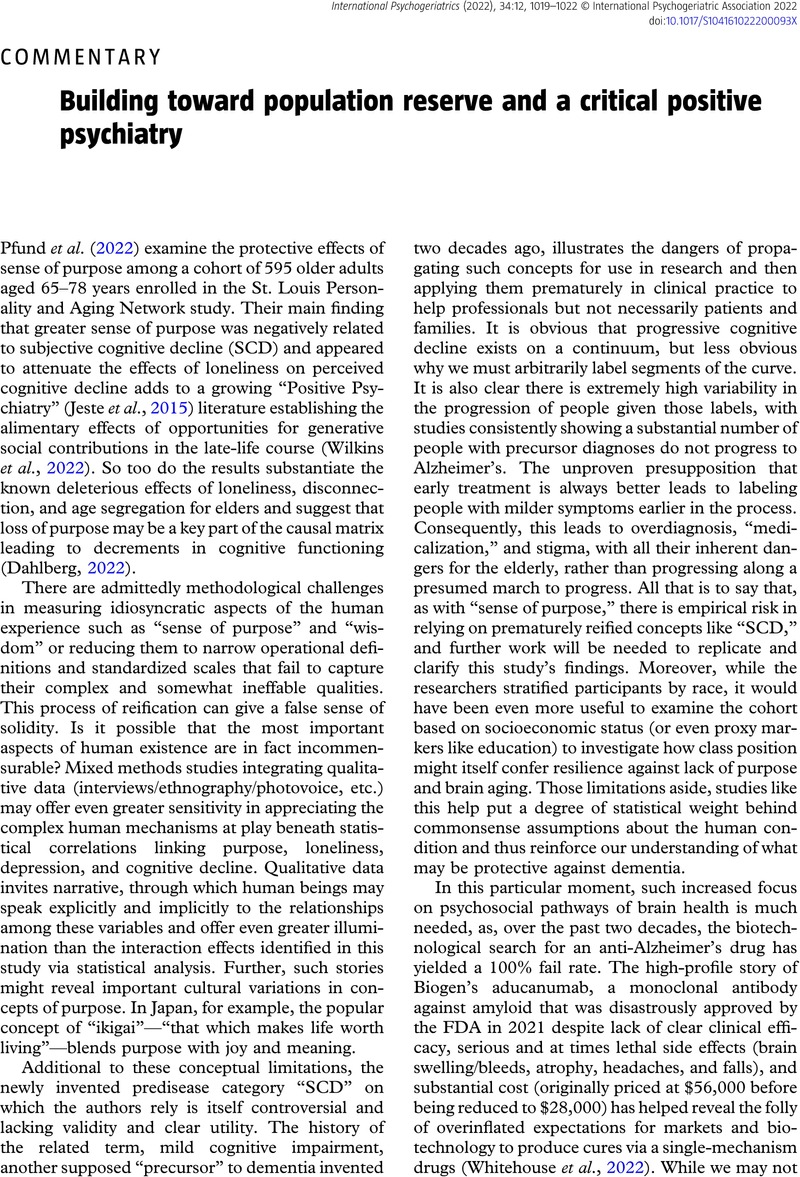No CrossRef data available.
Article contents
Building toward population reserve and a critical positive psychiatry
Published online by Cambridge University Press: 04 October 2022
Abstract
An abstract is not available for this content so a preview has been provided. Please use the Get access link above for information on how to access this content.

- Type
- Commentary
- Information
- International Psychogeriatrics , Volume 34 , Special Issue 12: Issue Theme: Subjective Cognitive Complaints: What Do They Predict? , December 2022 , pp. 1019 - 1022
- Copyright
- © International Psychogeriatric Association 2022
References
Aftab, A. and Waterman, G. S. (2021). Conceptual competence in psychiatry: recommendations for education and training. Academic Psychiatry, 45, 203–209. https://doi.org/10.1007/s40596-020-01183-3
CrossRefGoogle ScholarPubMed
Case, A. and Deaton, A. (2015). Rising morbidity and mortality in midlife among white non-Hispanic Americans in the 21st century. Proceedings of the National Academy of Sciences of the United States of America, 112, 15078–15083. https://doi.org/10.1073/pnas.1518393112
CrossRefGoogle ScholarPubMed
Case, A. and Deaton, A. (2020). Deaths of Despair and the Future of Capitalism. Princeton, NJ: Princeton University Press. https://doi.org/10.2307/j.ctvpr7rb2
Google Scholar
Case, A. and Deaton, A. (2021). Life expectancy in adulthood is falling for those without a BA degree, but as educational gaps have widened, racial gaps have narrowed. Proceedings of the National Academy of Sciences of the United States of America, 118, e2024777118. https://doi.org/10.1073/pnas.2024777118
CrossRefGoogle ScholarPubMed
Dahlberg, L. (2022). Lonely and sad and/or sad and lonely? International Psychogeriatrics, 34, 613–616. https://doi.org/10.1017/S1041610222000308
CrossRefGoogle ScholarPubMed
George, D. R. and Whitehouse, P. J. (2010). Intergenerational volunteering and quality of life for persons with mild-to-moderate dementia: results from a 5-month mixed methods intervention study in the United States. Journal of the American Geriatrics Society, 58, 796.CrossRefGoogle Scholar
George, D. R. and Singer, M. (2011). Intergenerational volunteering and quality of life for persons with mild to moderate dementia: results from a 5-month intervention study in the United States. American Journal of Geriatric Psychiatry, 19, 392–396.CrossRefGoogle ScholarPubMed
George, D. R. et al. (2021). Perceptions on diseases of despair by members of rural and urban high-prevalence communities: a qualitative study. JAMA Network Open, 4, e2118134. https://doi.org/10.1001/jamanetworkopen.2021.18134
CrossRefGoogle Scholar
George, D. R. and Whitehouse, P. J. (2021). American Dementia: Brain Health in an Unhealthy Society. Baltimore, MD: Johns Hopkins University Press.Google Scholar
Jeste, D. V., Palmer, B. W., Rettew, D. C. and Boardman, S. (2015). Positive psychiatry: its time has come. The Journal of Clinical Psychiatry, 76, 675–683. https://doi.org/10.4088/JCP.14nr09599
CrossRefGoogle ScholarPubMed
Lee, M. et al. (2022). Variation in population attributable fraction of dementia associated with potentially modifiable risk factors by race and ethnicity in the US. JAMA Network Open, 5, e2219672. https://doi.org/10.1001/jamanetworkopen.2022.19672
CrossRefGoogle ScholarPubMed
Livingston, G. et al. (2020). Dementia prevention, intervention, and care: 2020 report of the Lancet Commission. Lancet, 396, 413–446. https://doi.org/10.1016/S0140-6736(20)30367-6
CrossRefGoogle ScholarPubMed
McFarland, M. J., Hauer, M. E. and Reuben, A. (2022). Half of US population exposed to adverse lead levels in early childhood. Proceedings of the National Academy of Sciences of the United States of America, 119, e2118631119. https://doi.org/10.1073/pnas.211863111
CrossRefGoogle ScholarPubMed
Pell, M. B. and Schneyer, J. (2016, December 19). The Thousands of U.S. Locales Where Lead Poisoning Is Worse than in Flint. Reuters. Available at: https://www.reuters.com/investigates/special-report/usa-lead-testing/
Google Scholar
Pfund, G. et al. (2022). Sense of purpose as a potential buffer between mental health and subjective cognitive decline. International Psychogeriatrics, 1–11. https://doi.org/10.1017/S1041610222000680
CrossRefGoogle ScholarPubMed
Warren, M. (2022). “Pain in the Nation”. The Epidemics of Alcohol, Drug, and Suicide Deaths. Trust for America’s Health. Available at: https://www.tfah.org/wp-content/uploads/2022/05/TFAH_2022_PainIntheNation_Fnl.pdf
Google Scholar
Whitehouse, P. et al. (2022). Making the case for accelerated withdrawal of aducanumab. Journal of Alzheimer’s Disease, 87, 1003–1007. https://doi.org/10.3233/JAD-220262
CrossRefGoogle ScholarPubMed
Wilkins, J. et al. (2022). Predictors of the importance of everyday preferences for older adults with cognitive impairment. International Psychogeriatrics, 34, 287–294. https://doi.org/10.1017/S1041610220003956
CrossRefGoogle ScholarPubMed
Wolters, F. J. et al. (2020). Twenty-seven-year time trends in dementia incidence in Europe and the United States: the Alzheimer Cohorts Consortium. Neurology, 95, e519–e531.CrossRefGoogle ScholarPubMed
Woolf, S. H. and Schoomaker, H. (2019). Life expectancy and mortality rates in the United States, 1959–2017. JAMA, 322, 1996–2016. https://doi.org/10.1001/jama.2019.16932
CrossRefGoogle ScholarPubMed


